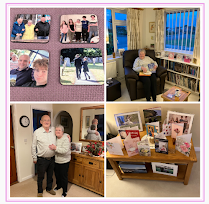 M0BXT's 1 valve transceiver (see left)
M0BXT's 1 valve transceiver (see left)Last night M0BXT and I had a nice two-way QSO with a difference.
Andrew used his 1 valve 300mW transceiver (see http://tetrode.co.uk/ ) and I was using the FETer 1 FET transceiver. Reports both ways were good over the two mile path.
With the help of Andrew's RF test gear I was able to accurately measure the sensitivity of the FETer rig and its power output. Sensitivity is better than -100dBm (around 2uV) for a reasonably comfortable level in the
 crystal earpiece. Signals could be detected (just) at around -105dBm sensitivity. The TX has a bit more power than I was able to measure crudely - around 18mW output with a 12V supply. These figures are really quite remarkable for the few parts used.
crystal earpiece. Signals could be detected (just) at around -105dBm sensitivity. The TX has a bit more power than I was able to measure crudely - around 18mW output with a 12V supply. These figures are really quite remarkable for the few parts used.Next aim is to work some further distances with the FETer. I am sure this will be possible.
.jpg)
.jpg)










